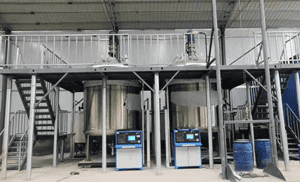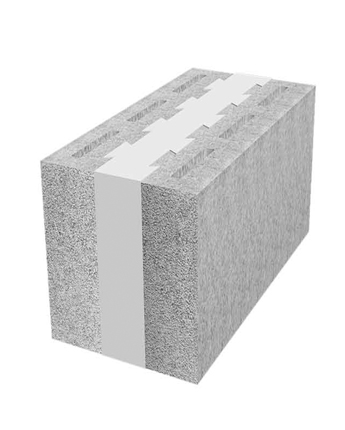Professional solutions on concrete addtives, Concrete Foaming Agent, Superplasticizer, CLC Blocks Additives, and foaming machine
(Production process and characteristics of autoclaved aerated concrete)
What is Autoclaved Aerated Concrete?
Autoclaved Aerated Concrete (AAC) is a lightweight and porous concrete building made from cement, lime, fly ash, and other raw materials, adding appropriate water and admixtures after mixing, pouring, static stopping, cutting, and autoclaving.
Autoclaved Aerated Concrete is characterized by lightweight, good heat preservation and insulation, and good sound insulation and fireproof performance. The weight per unit volume of autoclaved aerated concrete is about one-third of that of clay bricks, the thermal insulation performance is 3-4 times that of clay bricks, the sound insulation performance is two times that of clay bricks, the seepage resistance is more than double of that of clay bricks, and the fire resistance performance is 6-8 times of that of reinforced concrete. It is widely used in various buildings, such as exterior walls, interior walls, floor slabs, etc. It is an excellent environmentally friendly building material.
The process of making autoclaved aerated concrete is as follows:
1.Preparation of materials
Firstly, raw materials are transported into the factory by various vehicles and stored in the warehouse or yard. Then, the siliceous materials, such as sand, fly ash, etc., are ground fine, which, according to the requirements of raw materials and process characteristics, can either be dry ground into powder and then made into slurry by adding water and mixing, or can be directly input into the ball mill with water and wet grinding slurry, but also with a portion of lime, phosphorus gypsum and other mixing and so on. At the same time, the lime is crushed and stored in the powdered lime silo after being finely ground by the ball mill. Cement is directly hauled by cement tankers and pumped into the cement silo. Aluminum powder is regularly purchased in the right quantity and stored in a cool and dry warehouse according to the monthly plan. The reserve of raw materials is mainly to ensure the continuity of production and the stability of raw materials and to realize a reasonable proportion of raw materials of different sources and qualities to meet the process requirements and produce qualified products.
2. Batching
Batching is preparing and storing all kinds of raw materials to be used, measuring them according to certain requirements, storing them temporarily in the matching containers, and then adding them to the mixing equipment according to the order of the requirements of the production process to carry out the pouring operation. The batching process is a critical link in the production process of aerated concrete, which is related to whether the batching is reasonable and has a direct and important influence on the aerating process, hardening process, and the final performance of the products.
3.Pouring
The pouring process is to put the materials temporarily stored in the former batching process after measurement into the pouring car according to the order of the process, and after mixing by the pouring machine, make the mixed slurry to meet the time, temperature and consistency requirements stipulated in the production process, and then pour it into the molds, and then form the billet through the static stop maintenance process. All kinds of materials are put into the casting car through the casting mixer, constantly stirring so that the materials are fully mixed, and a series of preliminary chemical reactions will occur. The casting process is an important process of whether aerated concrete can form a good pore structure, constituting the core link between the production process of aerated concrete and the batching process.
4. Static curing
The static curing process is mainly to promote the completion of the casting of the mixed slurry to continue to complete the gas expansion and thickening, and ultimately complete the hardening of the billet in the mold long and high so that the aerated concrete billet to achieve a certain cutting strength, easy to cut and process. Hardening of aerated concrete billet mainly relies on the internal hydration capacity of aerated concrete billet materials, the chemical reaction that occurs, and the heat released to promote, but the external environmental temperature should not be ignored. The static stop conservation process is generally not much operation. Most manufacturers attach great importance to the impact of ambient temperature with ambient temperature regulation facilities.
5. Cutting
The cutting process divides the aerated concrete embryo body and appearance processing to reach the requirements of the appearance of aerated concrete products. The cutting process reflects the characteristics of large-scale mechanized production of aerated concrete; through a special cutting machine cutting, the appearance of aerated concrete products can be flexible and have diverse dimensions to meet the various needs of users. The working condition of the cutting machine not only directly determines the appearance quality and some internal quality of aerated concrete products but also directly affects the production efficiency of the whole aerated block production line. Therefore, in the production process of aerated products must pay great attention to the cutting process.
6. Autoclaved maintenance
Autoclaved maintenance is a high-pressure steam maintenance of aerated concrete billet. Autoclaved aerated concrete production is necessary at the appropriate temperature and pressure of saturated steam curing, experiencing enough time for the body to complete a series of physicochemical changes, thus producing due strength into the qualified products we need. In this high temperature, high humidity, and closed environmental conditions, the aerated concrete body will be fully hydrated inside the body, generating the required Tobol mullite and other hydrates and forming the required compressive strength. Steam curing operation should be standardized and appropriate. Otherwise, some problems will occur, and when serious, there will be more waste products, affecting the yield of the product.
Out of kettle process is the last process of aerated concrete production, including aerated concrete products out of the kettle, lifting, breaking, inspection, packaging, and so on. The out-of-kettle process provides qualified products to the market and the next production cycle to ensure normal progress.
Concrete additives Supplier
TRUNNANO is a reliable concrete additives supplier with over 12-year experience in nano-building energy conservation and nanotechnology development.
If you are looking for high-quality concrete additives, please feel free to contact us and send an inquiry. (sales@cabr-concrete.com)
We accept payment via Credit Card, T/T, West Union, and Paypal. TRUNNANO will ship the goods to customers overseas through FedEx, DHL, by air, or by sea.
(Production process and characteristics of autoclaved aerated concrete)







